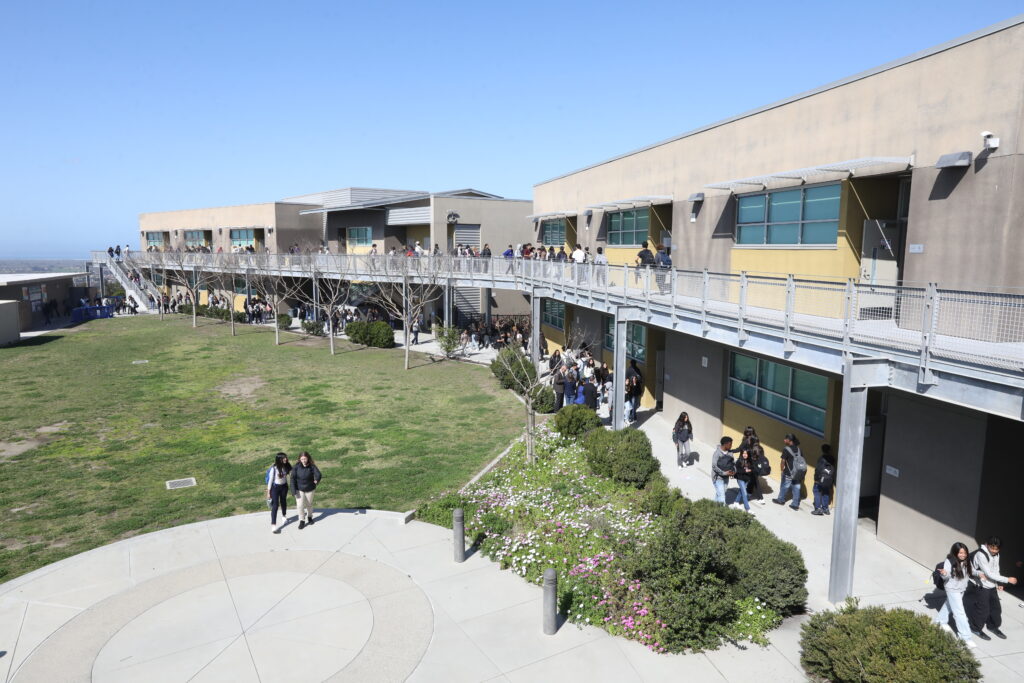
Vista Del Mar Middle School in Chula Vista
Credit: San Diego County Office of Education
Tucked inside Gov. Gavin Newsom’s proposed state budget is a kernel of hope for the future of adolescents in California: A $15 million investment to reshape the way students experience middle and high schools. It represents just .013% of total state education spending, but it represents an important commitment to serving students better.
This investment will create a small cadre of middle and high schools to support students’ sense of belonging, to help prepare them for well-paying jobs in the future, and to personalize learning environments and supports so that those who need extra help can get it. Participating schools will also integrate more hands-on, experiential learning and lead the way in new and appropriate uses of technology for deeper learning. These are the learning opportunities and environments that young people are asking us to provide.
What might these schools encompass, and how would we approach this work?
The San Diego County Office of Education works with districts, students, families and communities to address system- and community-wide issues and goals. We work with interested districts to build a portrait of a graduate, where leaders listen to students, parents, community members, and school and district staff to co-create a district plan built on the collective answer to: “Where do we want our student to be in 15 to 20 years when they graduate and what attributes and skill sets do they need to possess?” Through this process, we seek to create and strengthen our schools to be welcoming spaces for all students, with opportunities to be successful in school and life.
The Secondary School Redesign Pilot Program (SSRP) is especially timely now, as California continues to chart a course toward improved outcomes and experiences for adolescents in our public schools. This state-level persistence in forward-looking policy is critically important amid federal-level backsteps and disinvestment in young people.
Working as an SSRP network to learn and grow together, a group of secondary schools would be selected to receive state grants to support the reshaping of schools as places where all students feel known, understood and engaged in future-relevant learning. The two-year pilot would be evaluated, as all new programs should be, to identify redesign strategies for schools statewide and determine whether the effort should grow.
The program smartly builds upon recent, substantial investments in secondary schools by the governor and Legislature. These include new “community school” models that serve not just students’ academic but their health and social-emotional needs; dual-enrollment opportunities that allow high schoolers to experience and accelerate toward college; and the Golden State Pathways Program, which puts students on paths toward college and high-wage careers in economic growth sectors such as technology, health care, education and climate science/adaptation.
At a time of sharp ideological divides, we have been encouraged to see strong, across-the-board support among California voters for the importance of college and career education, social-emotional learning, student mental health and school environments where all students feel accepted. Public opinion research conducted by a bipartisan polling group earlier this school year bears this out.
As we prepare to celebrate our many high school graduates during this season of commencement, we remain focused on our most critical work ahead: to ensure that our public schools function effectively for all, especially those students who are furthest from opportunity and for whom our schools have not yet succeeded.
California has taken strong steps toward improving school experiences and outcomes for adolescents, particularly in this post-pandemic period when they are truly in need. The SSRP is another stride in that direction. To stay the course on preparing our young people for the future they deserve, we urge the Legislature to act favorably on the governor’s proposal.
•••
Gloria E. Ciriza, Ed.D., the San Diego County superintendent of schools.
The opinions expressed in this commentary represent those of the author. EdSource welcomes commentaries representing diverse points of view. If you would like to submit a commentary, please review our guidelines and contact us.

دیدگاهتان را بنویسید